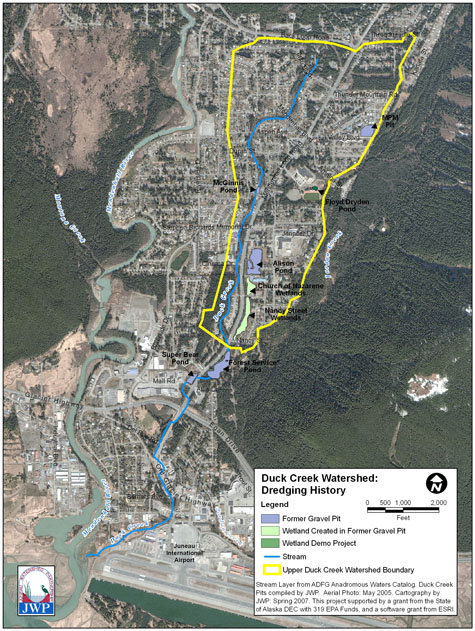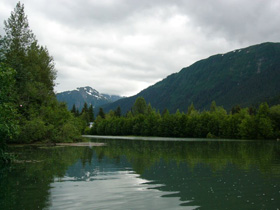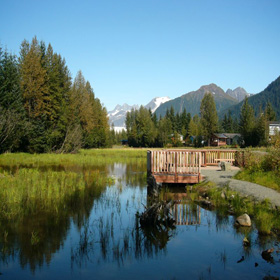Water Quality Monitoring: Duck Creek Nancy Street Wetland
The JWP in partnership with the Southeast Alaska Watershed Coalition (SAWC) and the University of Alaska Southeast (UAS) will collect data to determine the effectiveness of the Nancy Street wetland in improving water quality conditions on Duck Creek. Since 1994, Duck Creek was listed on the state’s Impaired Waters List for non-attainment of dissolved oxygen (DO), residues/debris, metals (specifically iron), fecal coliform bacteria, and turbidity standards. The Nancy Street wetland is one of many restoration projects completed on Duck Creek to improve water quality, but there has been little to no water quality monitoring to track the success of this and other restoration efforts. This project will compare data collected by UAS on Duck Creek prior to the establishment of the Nancy Street wetland with data obtained during the project. A Special Thanks to our UAS faculty partners: Dr. Eran Hood, Dr. Sonia Nagorski and Dr. Lisa Hoferkamp Funding Provided By: Alaska Department of Environmental Conservation Alaska Clean Water Actions Grant. The content of this website does not necessarily reflect the view and policies of the funders, nor do the funders endorse trade names or recommend the use of commercial products mentioned in this website. |
 |
|
BACKGROUND:During the 1950s and 60s, land along the east fork of Duck Creek was excavated for gravel, leaving several pits that became filled with groundwater that was high in iron and low in dissolved oxygen. This contributed to the poor water quality of Duck Creek. Several of the gravel extraction ponds (the Alison, Church of the Nazarene, Nancy Street, and Forest Service ponds) were recognized in the 1997 Juneau Wetlands Management Plan as having enhancement potential to improve water quality and fish habitat on Duck Creek. Since then, these ponds became a focal point for potential restoration efforts. The Church of the Nazarene pond was converted into a wetland in 1998 and the Nancy Street pond followed in 2006. The City and Borough of Juneau purchased the six acre property on which the Nancy Street pond was located to provide a fill disposal site for the development of the Thunder Mountain High School. The pond was transformed by placing and vegetating the fill from the high school site to create meandering stream channel with adjacent wetland and upland benches. This provided a variety of habitat types for fish and wildlife, and the wetland vegetation could help immobilize the iron floc, increase dissolved oxygen, and improve overall water quality. An interpretive trail and an overlook were provided to educate the community on the benefits of wetlands. |
Sources:
CBJ Engineering Department/Toner Nordling Associates Inc. East Fork Duck Creek Marsh Restoration. plan set.
Wright, S. J and P.K. Czapla. 2013. “Case Study: Nancy Street Wetland Enhancement” Alaska Coastal Revegetation & Erosion Control Guide. Alaska Department of Natural Resources, Division of Agriculture, Plant Materials Center, Palmer, AK. |
 |
 |
|||
| Photo 1: Nancy Street pond on Duck Creek, prior to being converted into a wetland. | Photo 2: Nancy Street wetland on Duck Creek, after two growing seasons. | ||||
Photos used with permission from Michele Elfers, CBJ Engineering Department. |
|||||
PARTICIPATE IN OUR NANCY ST. WETLAND USER SURVEY:
We're hoping to gather information about the community's perspectives on, and use of, the Nancy St. wetland. If you live near the wetland, or use the wetland for walking, birdwatching, nature drawing, photography, anything - - the JWP would like to hear from you! The survey should only take a few minutes to complete (10 questions total), and is completely anonymous. If you'd haven't yet participated, please click here to go to the electronic survey.
PROJECT STATUS:
The JWP and UAS developed a Sampling Plan and a Quality Assurance Project Plan (QAPP) to ensure that water quality monitoring is completed according to DEC’s standards.
A UAS Environmental Science Intern, Christin Khalsa, was hired in March 2017 to conduct the water quality monitoring and lab analysis. Monitoring began April 14, 2017 and will continue through October 2017. Monitoring sites are shown in the below interactive map.
Sampling for fecal coliforms and Escherichia coli bacteria at Site NSd began July 17, 2017 and occurred five times within a 30-day period to determine if water quality standards are met for these bacteria. Fecal coliform and E. coli were found to be well below the water quality standards.
LEARN MORE: read our blog article about this project, or the story covered by KTOO.
What water quality parameters will JWP be monitoring?
When creating a monitoring program, parameters much be selected to meet the sampling objectives. Since JWP must determine if the Nancy Street wetland is improving water quality on Duck Creek, we will focus on the water quality parameters of concern on Duck Creek: dissolved oxygen, turbidity, total suspended solids, total dissolved solids, iron, fecal coliform bacteria and E. coli. We will also take traditional water quality measurements such as temperature, pH, specific conductivity, and discharge.
